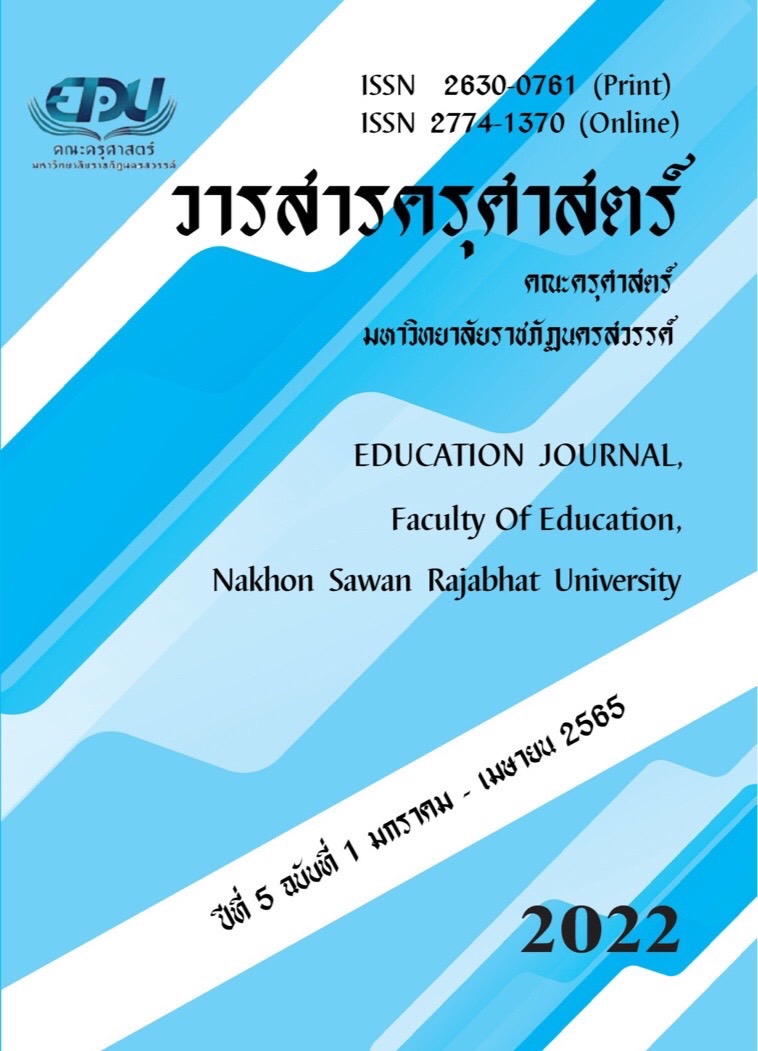Losing Creativity Thinking of Students in the 21st Century Education
Main Article Content
Abstract
Human has creativity thinking since they were born according to the theory of the psychologist in humanistic theory of creativity group. However, creative skill of each person is depending on their life experience, including nurture, environment, learning, social and culture. The advance of technologies and various appliances nowadays are form human intelligence, creativity and ability to create inventions to facilitate a more quality of lifestyles, for example, creating various kind of vehicles for travelling easily and quicky, using industrial machinery to increase productivity and reduce costs, and developing communication devices. It cannot be denied that all new ideas and innovations are based on human learning and creativity. Therefore, if people in a country have creative skills, this will be a factor leading to the development and civilization of that country. In the 21st century, the age of technology and innovation, machines and robots are increasingly being used instead of human labor, children should be developed and promoted in lifelong skills learning other than academic knowledge in order to live in a rapid change and unpredictable world.
Academic management platform in Thailand nowadays is still traditional education which focus on exams to get good grades, emphasis on passing or failing competitions, and centralized study courses, the courses are not caused by needs of learners, communities and societies. Moreover, family upbringing and environments also results in the fear of giving wrong answer, do not dare to think, speak out, and do what they want, these are one of many factors that cause the losing of children’s creativity.
Creativity thinking is a skill that can be taught and developed as creativity comes from the experience of each person. Thus, it is a challenge to Thai education system including teachers and parents who will be important person forcing the development and promoting creative skills in students to prepare them for their future work and life in the 21st century.
Downloads
Article Details

This work is licensed under a Creative Commons Attribution-NonCommercial-NoDerivatives 4.0 International License.
References
กรมวิชาการ,กระทรวงศึกษาธิการ. (2535). ความคิดสร้างสรรค์ หลักการ ทฤษฎี การเรียนการสอนการวัดผลประเมินผล. พิมพ์ครั้งที่ 2. กรุงเทพฯ : โรงพิมพ์ครุสภา.
ชลิดา หนูหล้า. (2563). ด้วยความระลึกถึงเคน โรบินสัน ผู้เชื่อมั่นในสีสันแห่งการเรียนรู้. สืบค้นเมื่อ 8 กันยายน 2564. แหล่งที่มา https://www.the101.world/sir-kenneth-robinson/
ธารทิพย์ ขัวนา และ ขวัญชัย ขัวนา. (2561). การจัดการเรียนรู้เพื่อส่งเสริมความคิดสร้างสรรค์เชิงผลิตภาพทางการศึกษา : สู่ยุค การศึกษาไทยแลนด์ 4.0. วารสารสถาบันวิจัยและพัฒนา มหาวิทยาลัยราชภัฏมหาสารคาม ปีที่ 5 ฉบับที่ 2 เดือน กรกฎาคม-ธันวาคม พ.ศ. 2561 แหล่งที่มา hile:///C:/Users/DELL/Downloads/211153-Article%20Text-665221-1-10-20190824.pdf
ธเนศ รัตนกุล ธเนศ รัตนกุล. (2562). อยากให้เด็กคิดอย่างสร้างสรรค์? ผู้ใหญ่ต้องทำให้เห็นก่อน. [ออนไลน์]. สืบค้นเมื่อ 1 กันยายน 2564. แหล่งที่มา https://thematter.co/science-tech/create-creativity-for-kids/77730
ปิยวุฒิ ปัญญาพี่. (2559). การพัฒนาความคิดสร้างสรรค์ รหัสวิชา 3400-1000. [ออนไลน์]. สืบค้นเมื่อ 3 กันยายน 2564. แหล่งที่มา http://www.phuketvc.ac.th/download/61/Study2.pdf
ปิยะพร ศักดิ์เกษม. (2562). จินตนาการสำคัญกว่าความรู้. [ออนไลน์]. สืบค้นเมื่อ 8 กันยายน 2564. แหล่งที่มา https://anowl.co/anowlrak/anowl_love14/
วีรศักดิ์ จันทร์สุข. (2564). ความคิดสร้างสรรค์. สืบค้นเมื่อ 7 กันยายน 2564. แหล่งที่มา http://www.krurock.com/T33101/TechnoC/TechnoC01_04.php
ศุภชัย บุญเสริม. (2561). ความสัมพันธ์ระหว่างสภาพแวดล้อมในชั้นเรียนต่อความคิดสร้างสรรค์และความพึงพอใจในชั้นเรียนวิทยาศาสตร์ของนักเรียน สังกัดสำนักงานเขตพื้นที่การศึกษามัธยมศึกษา เขต 26. วิทยานิพนธ์ครุศาสตร์มหาบัณฑิต. มหาสารคาม : มหาวิทยาลัยราชภัฎมหาสารคาม.
สรวงมณฑ์ สิทธิสมาน. (2563). ความคิดสร้างสรรค์ของเด็กไทยที่หายไป. [ออนไลน์]. สืบค้นเมื่อ
กันยายน 2564. แหล่งที่มา https://www.altv.tv/content/thaipbs-kids/5f6188f917d8e5bbee2401a1https://kasetsartjournal.ku.ac.th/kuj_files/2010/A1008311624350903.pdf
สุทธิวรรณ ตันติรจนาวงศ์. (2560). ทิศทางการจัดการศึกษาในศตวรรษที่ 21. [Abstract]. Journal of Silpakorn University Vol. 10 No. 2 (2017): ฉบับภาษาไทย มนุษยศาสตร์ สังคมศาสตร์ และศิลปะ (พฤษภาคม – สิงหาคม 2560). สืบค้นเมื่อ 1 กันยายน 2564. แหล่งที่มา https://he02.tci-thaijo.org/index.php/Veridian-E-Journal/article/view/109763
สุปราณี สนธิรัตน์. (2523). การปลูกฝังความคิดริเริ่มสร้างสรรค์ให้กับยุวกสิกร. วารสารวิทยาสารเกษตรศาสตร์ สาขาสังคมศาสตร์ ปีที่ 1 ฉบับที่ 1-2 ม.ค.-ธ.ค. 2523. สืบค้นเมื่อ 8 กันยายน 2564. แหล่งที่มา https://kasetsartjournal.ku.ac.th/kuj_files/2010/A1008311624350903.pdf
สำนักงานคณะกรรมการข้าราชการพลเรือน. (2560). หนังสืออิเล็กทรอนิกส์ การคิดเชิงสร้างสรรค์. [ออนไลน์]. สืบค้นเมื่อ 1 กันยายน 2564. แหล่งที่มา https://www.ocsc.go.th/sites/default/files/document/ocsc-2017-eb13.pdf
สำนักงานสภาพัฒนาการเศรษฐกิจและสังคมแห่งชาติ. (2561). ยุทธศาสตร์ชาติระยะ 20 ปี พ.ศ. 2561 – 2580. สืบค้นเมื่อ 7 กันยายน 2564. แหล่งที่มา http://nscr.nesdc.go.th
. (2564). แผนปฏิรูปประเทศ (ฉบับปรับปรุง) (ฉบับประกาศราชกิจจานุเบกษา). สืบค้นเมื่อ 7 กันยายน 2564. แหล่งที่มา http://nscr.nesdc.go.th
อารี รังสินันท์. (2527). ความคิดสร้างสรรค์. สืบค้นเมื่อ 3 กันยายน 2564. แหล่งที่มา http://www.nana-bio.com/Research/image%20research/research%20work/ceative%20thinking/creative%20thinking04.html
Baron ,& May. (1960). Psychology the essential science. Boston: Renslaer Polyte.
Dalton, M, D G. Hoyle; & M. W. Watts. (2000). Human Relations. 2nd ed. Ohio: SouthWestern Enucational Puplishing.
Guilford, J.P. (1950). Creativity. American Psychologist, 5 (9), pp. 444–454.
. (1967). Factor that aid and hinder creative. (3 rd ed). New York : McGraw – Hill.
Smith, G.I.W. (1987). “A New Creativity Test”, Journal of Creativve Behavior. 21 (1) : 7-14 ; First Quarter.
Torrance, E.P. (1974). Torrance tests of creative thinking. Bensenville, IL: Scholastic Testing Service, Inc.
Osborn, A. F. (1963). Creative imagination (3rd ed.). New York: Charles Scridners Sons.


